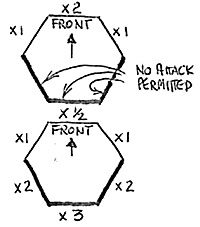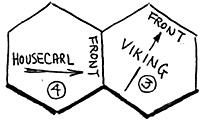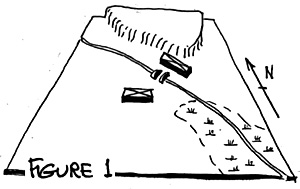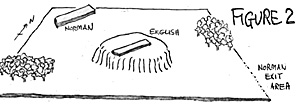WILLIAM has been around for some time; it's put out by TSR, the D&D boys, and for some unknown reason, I took a chance on it at a half price sale. It sells for $13, and for the price I paid for it, I think I got a deal.
INTRODUCTION
WILLIAM consists of 2 games: the battle at Stamford Bridge, wherein Hardrada and the English forces fended off the Vikings, and the battle of Hastings, in which Hardrada got his comeuppance from William the Conqueror, recently arrived from France.
I have nothing but good to say about the game counters and board. The tokens on each side are few in number, they are brightly colored, they are easily read, and - wonder of wonders!! - they are an inch or so in diameter, rendering them quite manipulable. The 'board' itself consists of a field of goodsized 1 1/8 inch hexes; the map is of a good quality, thick oil-cloth, with Stamford Bridge on one side, Hastings on the other.
THE SYSTEM
Combat resolution is 'diceless' . Each side chooses units adjacent to the enemy will attack which enemy unit, point values are summed and the result will be one of the following four:
- Attacker to defender ratio of
- 4:1 or more ... enemy destroyed
3:1 enemy pinned, cannot move or face for next move.
2:1 enemy pinned, but may face, not move on next turn.
1:1 no effect
 Facing is of extreme importance since both attack and defensive factors
depend on the configuration of adjacent units. The attacking unit gets its
points from 3 sources, all of which are multiplied together:
Facing is of extreme importance since both attack and defensive factors
depend on the configuration of adjacent units. The attacking unit gets its
points from 3 sources, all of which are multiplied together:
From its own configuration ...
From the configuration of its opponent ...
From terrain effects ...
 Thus a Housecarl at 4 combat points,
attacking uphill against a Viking, and hitting
him in the flank as shown, gets 4 Basic pts x 2
Attack to its own front x 2 Attack to the enemy
flank x 1/2 Attack uphill = 8
Thus a Housecarl at 4 combat points,
attacking uphill against a Viking, and hitting
him in the flank as shown, gets 4 Basic pts x 2
Attack to its own front x 2 Attack to the enemy
flank x 1/2 Attack uphill = 8
The Viking, who is worth 3 combat points, thus has 8 to 3, or, rounded down, 2:1 against him; he is pinned for the next turn.
Combat points may be augmented by stacking one leader token (William, Hardrada, Tostig, etc ) with a regular one. This is the only allowed stacking procedure.
The move sequence is termed 'revolutionary' in the rules book; I didn't find it so revolutionary as unique. The sequence consists of 5 phases:
- a. Attacker fires
b. Attacker moves
c. Defender fires
d. Combat moves
e. Combat resolution
Offhand, the 5 listed phases don't seem out of the ordinary, however, Phase (d) incorporates an interesting procedure.
During Phase (b) the attacking side advances its units, placing pieces next to enemy ones preparatory for the combat phase. Then when the combat phase, Phase (d) arrives, the defender may do the following:
- a. He may move each piece in contact one hex, and
b. He may reface each piece in contact
The defender does this by placing a Move chit and a Face chit on each of the counters the attacker has moved next to; when the attacker then starts to indicate who is attacking who, the chits are revealed and it is discovered if the target units have 'sidestepped' or refaced or fallen back one hex. The attacker, therefore, may wind up with no attack at all, should the defending units cleverly 'slither' out of the way.
THE GAME
The Battle of Stamford Bridge pits the following forces against one another:
| English Unit | No of units | Combat points | Movement points |
|---|---|---|---|
| Housecarls | 10 | 4 | 3 |
| Fyrds (militia) | 26 | 2 | 3 |
| Thegns (cavalry) | 7 | 3 | 6 |
| Viking Unit | No of units | Combat points | Movement points |
| Vikings | 26 | 3 | 4 |
| Archers | 4 | 1 | 4 |
 The map is sketched in Figure 1.
The map is sketched in Figure 1.
The two infantry units shown are the Vikings, in place. The English come on the field from the south edge. If the Vikings can withdraw and arrange themselves along the northern bank of the river, it becomes almost impossible to break their line. The best tactic of the English, it was found, was to pin the forward Viking unit with cavalry, while sending the remaining cavalry units to the west to cross the river and outflank the defenders.
The Battle of Hastings has this order of battle:
| English Unit | No of units | Combat points | Movement points |
|---|---|---|---|
| Housecarls | 7 | 4 | 3 |
| Fyrds (militia) | 22 | 2 | 3 |
| Norman Unit | No of units | Combat points | Movement points |
| Knights | 8 | 4 | 6 |
| Archers | 8 | 1 | 4 |
| Men-at-arms | 11 | 3 | 3 |
 The start position of the 2 forces is shown on the map of Figure 2.
The start position of the 2 forces is shown on the map of Figure 2.
In an effort to simulate the manner in which William's men were able, on occasion, to lure the English off the hill, the victory conditions provide for Norman victory points if William can exit men off the southeast corner. Thus the English are forced to sally forth down the hill to stop the Normans from flowing past the hill to the exit area.
CONCLUSIONS
Included in the box is a 'combat sliderule', a completely useless gadget concerning which TSR could have saved money, time and effort. It purports to tell - and probably does - what combat multipliers apply to a given situation, however, after trying it once or twice, we jettisoned it. A good idea gone bad.
Usually, the very name "TSR" associated with a gaming effort makes my hackles rise (... what are hackles, Daddy?). But in this case, I must admit the WILLIAM THE CONQUEROR proved rather enjoyable.
It seems to contain all my criteria for a boardgame: it has few tokens to push, it has little or no stacking, it has large, readable counters, it has huge hexes, and it goes rapidly, It should be noted that WILLIAM doesn't seem to have made the best-seller lists, so my criteria evidently clash with those of the average boardgamer. This bothers me not one jot nor one tittle; my criteria usually clash with everyones' anyway. Try WILLIAM THE CONQUEROR.
Back to PW Review December 1981 Table of Contents
Back to PW Review List of Issues
Back to MagWeb Master Magazine List
© Copyright 1981 Wally Simon
This article appears in MagWeb (Magazine Web) on the Internet World Wide Web.
Other military history articles and gaming articles are available at http://www.magweb.com